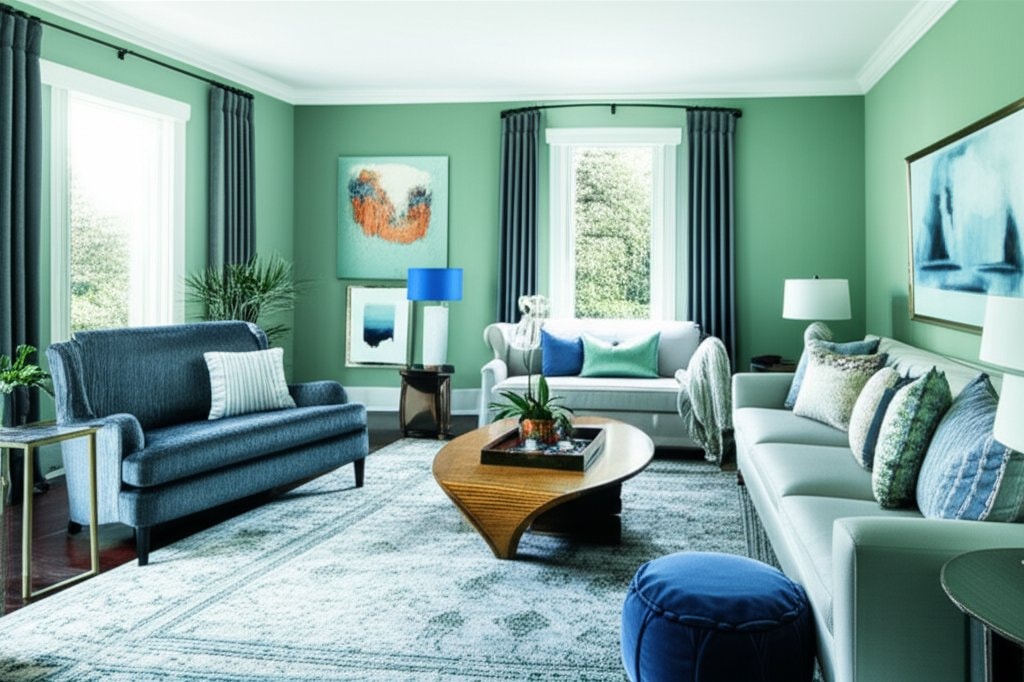2025's Cool Blues and Sage Greens: Transform Your Home with Calm
Color trends in home design mirror evolving lifestyles, with a growing emphasis on spaces that foster relaxation and balance. Cool blues and sage greens emerge as leading choices for 2025, ideal for walls, trim, and accents. These hues deliver timeless serenity in modern or traditional settings, enhanced by thoughtful finishes that avoid any stark chill.
This guide details the expenses involved in painting with these popular shades, key pricing influences, and strategies for cost-effective execution. Whether refreshing one room or revamping your entire house, grasping these elements empowers informed choices that align with your vision and budget.
Key Factors Influencing Painting Costs
Multiple elements determine the expense of applying cool blues and sage greens. Reviewing them allows you to establish accurate project estimates.
Paint Quality and Finish
High-end paints provide superior coverage, vibrant pigments, and extended durability. Basic interior paint runs $25 to $45 per gallon, whereas specialty or low-VOC options in sage or blue tones climb to $60 to $100 per gallon. Opt for matte or eggshell for affordability; select satin or semi-gloss for added resilience, though at a premium price.
Room Dimensions and Intricacies
Bigger areas demand more paint and time, elevating totals. High ceilings beyond nine feet, angled vaults, or ornate molding extend labor. Introducing accent walls in bolder variants raises costs through extra masking and edging efforts.
Surface Preparation Requirements
Tasks like patching cracks, smoothing surfaces, applying primer, and sealing gaps add $1 to $3 per square foot. Properties with deteriorated legacy paint often require thorough groundwork to ensure flawless adhesion and finish.
Professional Service Versus Self-Execution
Experts guarantee uniform application and swift turnaround, yet incur steeper fees. Tackling it yourself cuts labor by 40 to 60 percent, provided you invest in supplies, dedicate hours, and possess the necessary expertise for polished outcomes.
Location-Based Labor Variations
Expenses fluctuate geographically. High-demand city centers command elevated rates, whereas outlying suburban or countryside zones typically present more economical options.
Project Timing by Season
Peak periods in spring and summer heighten painter workloads, inflating bids. Booking in quieter months like fall or winter frequently yields reduced pricing.
Selecting Cool Blues or Sage Greens
Each palette imparts tranquility, distinguished by their subtle tones and emotional resonance.
- Cool Blues: These shades inspire crispness, vitality, and spaciousness. They suit bedrooms, bathrooms, or expansive living zones. Combine them with stark whites, soft grays, and wood elements for harmony.
- Sage Greens: Offering gentle warmth rooted in nature, they soothe kitchens, dining areas, and foyers. Integrate with terracotta hues, metallic brass, and textured woods for grounded elegance.
Pricing variances stem from color depth; intense blues might necessitate extra layers, appending $100 to $300 per space.
Strategies to Control Expenses
Implement these tactics to curb outlays while upholding excellence:
- Perform initial prep solo: Address minor repairs, light abrasion, and wall cleansing to trim $300 to $600 from bills.
- Choose durable mid-tier paints: Washable formulas strike an optimal balance between cost and longevity, minimizing future touch-ups.
- Confine accents strategically: Apply pigment-rich colors to a single wall per room, conserving materials and effort.
- Time projects off-season: Lower demand translates to discounted services from contractors.
- Shop sales for supplies: Watch for promotions on trending colors during retail transitions.
Weighing Professional Help Against DIY
Self-painting suits modest undertakings if you handle rollers, brushes, and drop cloths adeptly. Materials for one room total $150 to $300, versus $500 to $1,200 for hired work. Success hinges on meticulous prep and steady application; otherwise, imperfections may arise.
Professionals excel in complex scenarios, such as multi-room jobs or intricate details, delivering efficiency and precision worth the investment.
Launching Your Painting Initiative
Begin by curating your color scheme from cool blues or sage greens. Obtain swatches and apply them to walls, observing shifts in natural, artificial, and evening light. With selections confirmed, solicit estimates from three or more licensed painters to compare terms and timelines.
Frequently Asked Questions
Average Cost for Cool Blues or Sage Greens Painting?
Professional services, encompassing materials and labor, average $2 to $6 per square foot. For a typical three- to four-bedroom home, anticipate $3,000 to $8,500 overall. A standard room falls between $400 and $1,200, scaled by dimensions and specifications.
Primary Cost Drivers in Painting Projects?
Paint grade, area scale, prep demands, and regional wages dominate expenses. Opting for upscale formulas or multiple coats on saturated shades adds $100 to $300 per area. Priming or mending surfaces contributes another $1 to $3 per square foot.
Ways to Cut Costs While Maintaining Standards?
Undertake basic prep independently, favor resilient mid-level paints, and restrict feature walls. Off-peak scheduling and sale purchases further economize without compromise.
Professionals or DIY: Best Choice?
DIY works for compact spaces with your available schedule and aptitude. Engage experts for expansive areas, elevated architectures, or fine details to secure superior finishes and time savings. Evaluate based on your capabilities and priorities.
Budgeting for Surprises in Painting?
Incorporate a 10 to 15 percent buffer for unforeseen needs. Frequent add-ons involve drywall fixes, surplus paint for opaque coverage, or enhanced sheens for practicality.
Optimal Timing for Cost-Effective Painting?
Avoid spring and summer rushes when availability tightens and rates rise. Fall and winter slots often secure better deals and prompt service.
Realize Lasting Serenity in Your Spaces
Mastering these costs and approaches enables a seamless shift to cool blues and sage greens. Beyond aesthetic renewal, these selections cultivate enduring comfort, elevate property appeal, and deliver substantial returns on your efforts.



